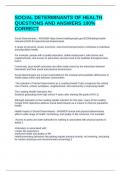SOCIAL DETERMINANTS OF HEALTH
QUESTIONS AND ANSWERS 100%
CORRECT
Social Determinants - ANSWER-https://www.healthypeople.gov/2020/leading-health-
indicators/2020-lhi-topics/Social-Determinants
A range of personal, social, economic, and environmental factors contribute to individual
and population health.
For example, people with a quality education, stable employment, safe homes and
neighborhoods, and access to preventive services tend to be healthier throughout their
lives.1
Conversely, poor health outcomes are often made worse by the interaction between
individuals and their social and physical environment.
Social determinants are in part responsible for the unequal and avoidable differences in
health status within and between communities.
The selection of Social Determinants as a Leading Health Topic recognizes the critical
role of home, school, workplace, neighborhood, and community in improving health.
The Leading Health Indicators Are:
Students graduating from high school 4 years after starting 9th grade (AH-5.1)
Although education is the Leading Health Indicator for this topic, many of the Healthy
People 2020 objectives address social determinants as a means to improve population
health.
Health Impact of Social Determinants - ANSWER-Social and physical determinants
affect a wide range of health, functioning, and quality of life outcomes. For example:
-Access to parks and safe sidewalks for walking is associated with physical activity in
adults.2
-Education is associated with:
Longer life expectancy
Improved health and quality of life
Health-promoting behaviors like getting regular physical activity, not smoking, and going
for routine checkups and recommended screenings.3
,-Discrimination, stigma, or unfair treatment in the workplace can have a profound impact
on health; discrimination can increase blood pressure, heart rate, and stress, as well as
undermine self-esteem and self-efficacy.3
-Family and community rejection, including bullying, of lesbian, gay, bisexual, and
transgender youth can have serious and long-term health impacts including depression,
use of illegal drugs, and suicidal behavior.4
-Places where people live and eat affect their diet. More than 23 million people,
including 6.5 million children, live in "food deserts"—neighborhoods that lack access to
stores where affordable, healthy food is readily available (such as full-service
supermarkets and grocery stores).5
Social Determinants Across the Life Stages - ANSWER-From infancy through old age,
the conditions in the social and physical environments in which people are born, live,
work, and age can have a significant influence on health outcomes.
Children
Early and middle childhood provide the physical, cognitive, and social-emotional
foundation for lifelong health, learning, and well-being.
A history of exposure to adverse experiences in childhood, including exposure to
violence and maltreatment, is associated with health risk behaviors such as smoking,
alcohol and drug use, and risky sexual behavior, as well as health problems such as
obesity, diabetes, heart disease, sexually transmitted diseases, and attempted suicide.6
Features of the built environment, such as exposure to lead-based paint hazards and
pests, negatively affect the health and development of young children.
Adolescents
Because they are in developmental transition, adolescents and young adults are
particularly sensitive to environmental influences.
Environmental factors, including family, peer group, school, neighborhood, policies, and
societal cues, can either support or challenge young people's health and well-being.
Addressing young people's positive development facilitates their adoption of healthy
behaviors and helps to ensure a healthy and productive future adult population.
Adolescents who grow up in neighborhoods characterized by poverty are more likely to
be victims of violence; use tobacco, alcohol, and other substances; become obese; and
engage in risky sexual behavior.7
Adults
Access to and availability of healthier foods can help adults follow healthful diets.
, For example, better access to retail venues that sell healthier options may have a
positive impact on a person's diet.
These venues may be less available in low-income or rural neighborhoods.
Longer hours, compressed work weeks,
Disparities and Social Determinants - ANSWER-Race and ethnicity, gender, sexual
identity, age, disability, socioeconomic status, and geographic location all contribute to
an individual's ability to achieve good health.
It is important to recognize the impact that social determinants have on health outcomes
of specific populations.
Social determinants are often a strong predictor of health disparities. For example:
-In 2007 to 2008, the Asian or Pacific Islander population had the highest rate of high
school graduation among racial and ethnic groups, with 91.4% of students attending
public schools graduating with a diploma 4 years after starting 9th grade compared to
rates among non-Hispanic white (81.0%), American Indian or Alaska Native (64.2%),
Hispanic (63.5%), and non-Hispanic black (61.5%) populations.
-According to the National Assessment of Adult Literacy, African American, Hispanic,
and American Indian or Alaska Native adults were significantly more likely to have
below basic health literacy compared to their white and Asian or Pacific Islander
counterparts. Hispanic adults had the lowest average health literacy score compared to
adults in other racial and ethnic groups.10
-In 2007, African Americans and Hispanics were more likely to be unemployed
compared to their white counterparts. Further, adults with less than a high school
education were 3 times more likely to be unemployed than those with a bachelor's
degree.11
-Low socioeconomic status is associated with an increased risk for many diseases,
including cardiovascular disease, arthritis, diabetes, chronic respiratory diseases, and
cervical cancer as well as for frequent mental distress.11
-Low-income minorities spend more time traveling to work and other daily destinations
than do low-income whites because they have fewer private vehicles and use public
transit and car pools more frequently.
Students who graduate with a regular diploma 4 years after starting 9th grade (AH-5.1) -
ANSWER-Where We've Been and Where We're Going
The on-time graduation rate in public schools, defined by the percentage of students
awarded a high school diploma 4 years after starting 9th grade, increased by 4%, from




